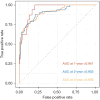Exploring the impact of variable power outputs on the efficacy and safety during microwave ablation for lung carcinoma: a real-world study
- PMID: 39268093
- PMCID: PMC11388260
- DOI: 10.21037/jtd-24-557
Exploring the impact of variable power outputs on the efficacy and safety during microwave ablation for lung carcinoma: a real-world study
Abstract
Background: Microwave ablation (MWA) is an important method for the treatment of lung cancer, but there is still a lack of standard guidelines for the selection of power. This study aimed to explore the effectiveness and safety of MWA at different power levels.
Methods: The study gathered individuals underwent MWA for lung cancer between January 2012 and December 2020. All patients were divided into low power group and high power group based on the power of MWA. By intergroup comparisons, we clarified the differences between the two groups.
Results: In this study, 265 participants were involved, with 192 in the low power group and 73 in the high power group. Compared to the low power group, the high power group had a significantly higher incidence of postoperative complications (63.0% vs. 24.0%). In the Kaplan-Meier analysis, overall survival (OS) and disease-free survival (DFS) of the high power group were both better than the low power group. We found through Cox regression analysis that smoking, tumor volume, tumor differentiation, gene mutation, neutrophil count, and lymphocyte count were independent factors affecting the OS of patients. Based on the above factors, we constructed a nomogram, with areas under the curve (AUCs) of 0.941, 0.903, and 0.905 for predicting 1-, 2-, and 3-year OS after MWA, respectively.
Conclusions: While high-power MWA brings better long-term prognosis to patients, it also leads to an increase in postoperative complications. The application of a nomogram for stratifying the prognosis of patients may be a more feasible approach to further develop individualized treatment plans.
Keywords: Lung carcinoma; complication; microwave ablation (MWA); power; prognosis.
2024 Journal of Thoracic Disease. All rights reserved.
Conflict of interest statement
Conflicts of Interest: All authors have completed the ICMJE uniform disclosure form (available at https://jtd.amegroups.com/article/view/10.21037/jtd-24-557/coif). The authors have no conflicts of interest to declare.
Figures



Similar articles
-
Different power modes of microwave ablation for hepatocellular carcinoma: Evaluation of recurrence rate and factors related to recurrence.Asian J Surg. 2023 Sep;46(9):3520-3528. doi: 10.1016/j.asjsur.2023.03.070. Epub 2023 Mar 29. Asian J Surg. 2023. PMID: 37002048
-
A Real-World Comparative Study of Microwave and Radiofrequency Ablation in Treatment-Naïve and Recurrent Hepatocellular Carcinoma.J Clin Med. 2022 Jan 7;11(2):302. doi: 10.3390/jcm11020302. J Clin Med. 2022. PMID: 35053997 Free PMC article.
-
A nomogram to predict survival of patients with intermediate-stage hepatocellular carcinoma after transarterial chemoembolization combined with microwave ablation.Eur Radiol. 2020 Apr;30(4):2377-2390. doi: 10.1007/s00330-019-06438-8. Epub 2020 Jan 3. Eur Radiol. 2020. PMID: 31900694
-
Comparison of microwave ablation and radiofrequency ablation for hepatocellular carcinoma: a systematic review and meta-analysis.Int J Hyperthermia. 2019;36(1):264-272. doi: 10.1080/02656736.2018.1562571. Epub 2019 Jan 24. Int J Hyperthermia. 2019. PMID: 30676100
-
The efficacy of microwave ablation versus liver resection in the treatment of hepatocellular carcinoma and liver metastases: A systematic review and meta-analysis.Int J Surg. 2020 May;77:85-93. doi: 10.1016/j.ijsu.2020.03.006. Epub 2020 Mar 12. Int J Surg. 2020. PMID: 32173611
References
LinkOut - more resources
Full Text Sources
